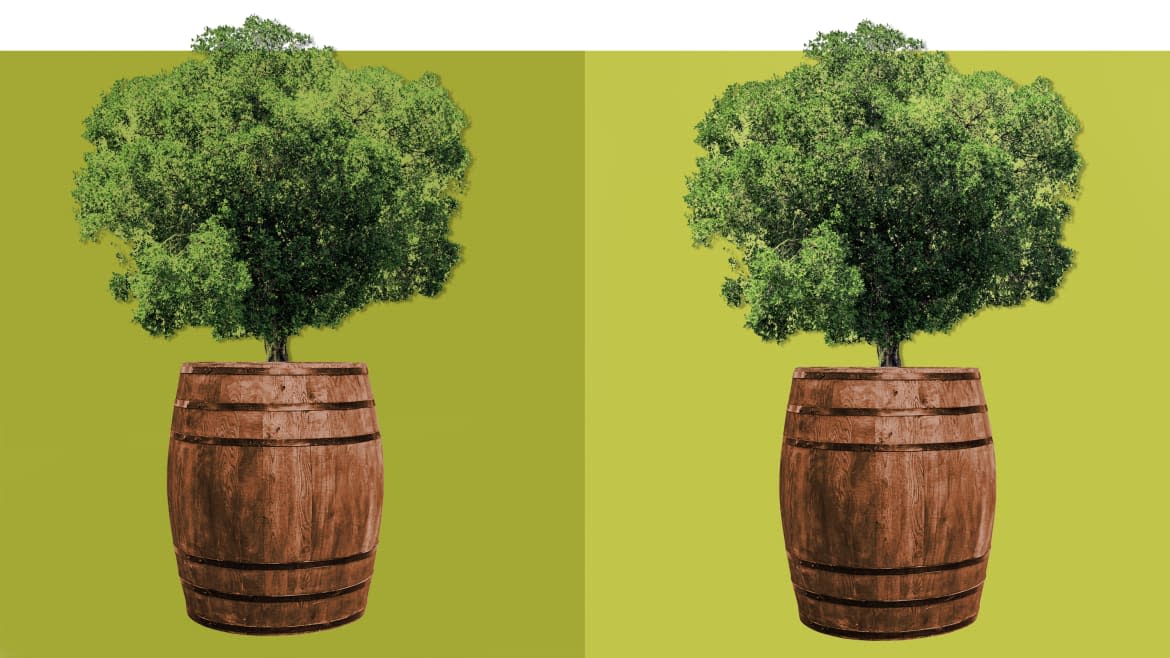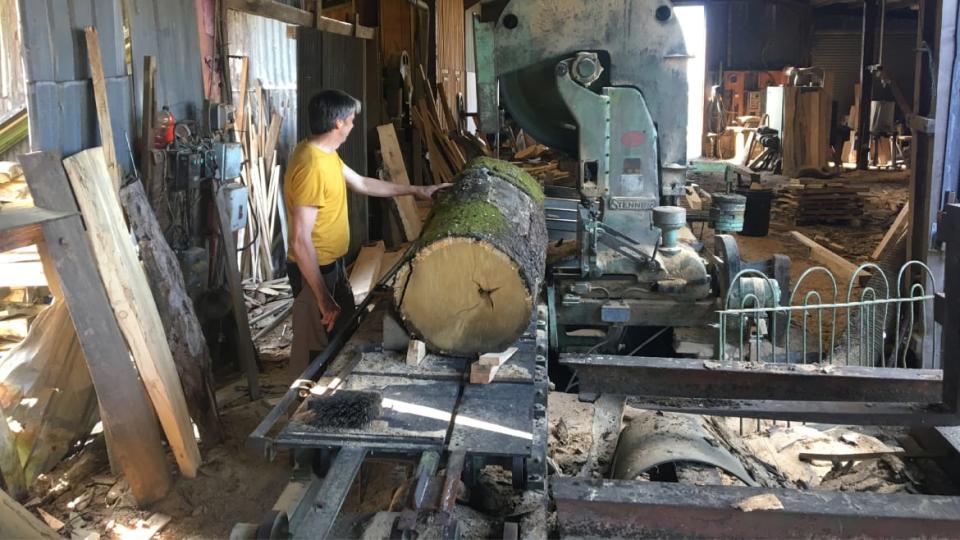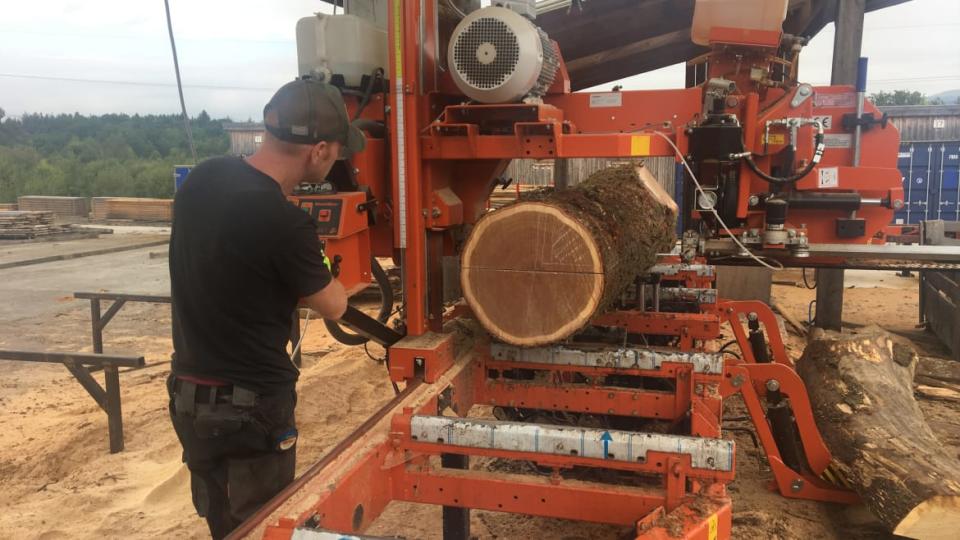The Next Big Thing in Scotch Whisky Could Be Homegrown

We’re in Drumore Wood, 15 miles outside Glasgow near the pretty, quiet village of Killearn. Gregg Glass is hugging a tree and gazing up its trunk. “Yes,” he says, after a long pause, “I think this one will do.” Forester George Broadhurst nods, takes out a can of spray paint and tags the tree, indicating it is to be felled.
Don’t worry, this is a managed forest, part of a 2,700-acre farm, which is looking at new ways to diversify its income stream. “Most of the timber has been sold for firewood or fence posts,” Broadhurst explains. “It’s time-consuming and financially unsustainable. Firewood has to be cut and dried, then we go out and sell it. You make no money. The new project is about providing a better economic base, and maintaining biodiversity.”
This is where Glass comes in. The assistant blender at Whyte & Mackay who also heads up its Whisky Works experimental arm, he is pioneering a long-term project to use Scottish oak for aging whisky. That, of course, starts with finding the right tree, something that I rapidly discover is not as straightforward as it may seem. I wander about, trying to find a tree that has girth, straightness and is nine-feet before the first branches.
“That one?”
Glass shakes his head at my choice. “No good. Pippy oak. See all the small shoots coming off the side? They’ll create knots making it unusable as a stave.”
“It’s good for high-end carpentry though,” adds Broadhurst, explaining the seven different quality grades of trunk, the lowest being for firewood and fencing, the highest ‘whisky sticks.’”
Even that concept was strange. I’d been brought up on the belief that, even if you could find it, Scottish oak simply wasn’t suitable for coopering. Glass had heard the same, but didn’t buy the story. “I was told it was too porous, there were supply issues, that coopers no longer built new casks and it would be cost prohibitive, but whisky makers are problem solvers, so I began to wonder how I could make it work.”
This was around 15 years ago. He started haunting sawmills and collecting bits of oak to run macerations and charring trials at home. “About five years ago, I was considering starting my own company, but as the trials developed, I began to think whether it could be upscaled to help the whole industry.”
Oaks have been growing in Scotland for 9,000 years. Sessile [Q.petraea] came first, and still holds on in poorer acidic ground, then Q.robur settled down into the richer post-glacial soils. Oak became the dominant broadleaf tree, a sacred being, the emblem of hospitality. Its days of worship were short-lived, though, as it turned from symbol to resource, used for housing, ships, furniture and coal mine pit props. Forests were felled to feed industry and make way for houses. By 1914, Britain was importing 90 percent of its timber.
Even the creation of the government-controlled Forestry Commission five years later did nothing to arrest oak’s rapid decline. Hardwoods were felled to make way for more rapid-growing softwoods, like larch and spruce. Scotland’s native forests dwindled, replaced by dark green monocultures. Sawmills began closing.
In the late afternoon light, piles of sawdust glow golden, softening the sharp edges of old blades. We’re at Moyne Sawmill, a one-man operation that Glass favors. Owner John Ferguson has been working it since 1989 and seen the wider decline. “The big sawmills diversified into fencing, which had been our area. There were five or six other mills around here, but there’s only me now. I needed to diversify.” As well as sawing and seasoning wood for Glass, he has moved into high-end woodworking.

He manipulates a massive oak trunk onto the bench, slowly guiding it through the blade. Moss, lichen and bark fly off, then comes the smell: spicy, caramel-like, as sweet as sugar cane. “There’s big stocks of American oak in Glasgow,” he says. “It’s a pleasing looking wood, but it’s mundane. Scottish oak has more character. This is a good one for Gregg, but out of two 12-foot sticks only half might be useable. It’s a precious commodity, but there’s demand for something which is less mass-produced, made by hand.”
The issue is volume. If the project is to succeed there needs to be a sustainable supply for the whisky industry, not just the odd windblown tree.
That is how Glass found Scottish Wood in the appropriately named Fife village of Oakley. Over the past 25 years, Jim Birley has grown it to become the largest hardwood sawmill in the country. “In 1998, little was happening in terms of hardwood,” he explains. “There were only a handful of sawmills, but there was no training or knowledge, so six of us got together to found ASHS [the Association of Scottish Hardwood Sawmills]. Now there’s 34 members, of which 12 are sawmills.”

But is there enough oak? “There’s plenty! Scotland has a lot of good oak. The trouble is that it all ends up on the continent. They like it because it has character. All the value is added outside of Scotland, but this project helps. It’s an exciting thing because the whole chain was broken.”
It strikes me that hardwoods are like the Scottish fishing industry selling its catch directly to Spanish and French wholesalers. I go to bed and dream of oaks turning into giant prawns.
“Oak is an important component in the Caledonian picture,” says Alex Baxter the next day. “They set the tone of a woodland, because they live the longest.” He, Glass and I are walking through the woods of Dundreggan, headquarters of Trees for Life, a charity that is re-establishing Scottish native woodlands. Two million trees have been planted already in the project to link the glens of Affric, Shiel, Canach and Moriston with mature forest running from the river to montane scrub, creating green corridors that will help biodiversity, lock in carbon and restore balance to the environment.
We’re standing beside six beds filled with tiny oak trees. “Most of these will return to the glen where they were collected,” he explains. “Mixed planting allows the mitochondrial network to flourish. Pines are happiest with other trees and it can all happen with minimal human intervention.”
“There’s been a 200- to 300-year process of logging and harvesting,” he continues. “There’s been high-impact grazing by sheep, then an explosion of deer for sporting estates.” The impact is deforestation. I think of all the times I’ve walked in this landscape and marveled at the bleak beauty. I’ve been looking at a desert, where there should be trees.
“Trees for Life are part of this project,” says Glass. “From a whisky industry perspective it will be great to see more people using Scottish oak, but it is also about responsible sourcing and replanting. I soon realized that this is not just about casks, but Scottish oak as a whole: replanting, managing forests, sawmills and cooperages. It’s about creating a gold standard for Scottish oak.”
The apprentice starts to build the cask, oblivious to the din of hammer against steel and wood around him. Seasoned staves from a Killearn tree, quarter-sawn by Jim Birley are nimbly fitted together, then lifted over a fire to be toasted, then steamed, Finally, the heads are cut and inserted. The ancient craft dating back to the days when oak was still worshipped.
I’m at the Speyside Cooperagecin Craigellachie speaking with general manager Andrew Russell. “Why use Scottish oak?” he asks rhetorically. “There’s no reason not to! It’s important because it is Scottish. Any whisky aged in Scottish oak will be sought after because of the provenance. OK, it will be expensive because of the work, and the low yield from each tree. It will never be huge, but it can be an important element in the future mix. We’ve placed an order with Jim Birley for the next three years, we’re now involved with ASHS and Trees for Life.”
I ask what’s surprised him the most about it. “You think of Scotland as a country of trees, but there’s low sawmill capability, often with the wrong equipment, but there’s great people. You know the other thing that struck me, Dave? They saw us as saviors.”
“Andrew is on the same wavelength,” says Glass as we drive south. “He’s the perfect partner because he can supply casks to the industry. For me it’s always been about opening this up to the industry. One whisky firm should not own Scottish oak.”
Glass’ trials have shown that Scottish oak can give an intense, sweet cinnamon note. He first used it as “seasoning” in the Whisky Works release King of Trees and has more whiskies in the pipeline. “The possibilities are practically limitless,” he enthuses, “and the more releases there are, the more learning we can all share.” He’s aware that the project is in its infancy. It changes your perspective on long-term planning. Trees planted today, will only be harvested in 100 years time.
More research is needed. While Scottish oak is technically from the same two species as most of the rest of Europe, the conditions are different, meaning that the parameters for seasoning, toasting, charring in order to maximize its flavor potential and character will have to be learned. Again, that will take time.
The deeper Glass has gone into the forest, the more links in the chain he’s found—links which were broken. What started as a whisky project now binds together biodiversity, forestry, sawmills, cooperages, furniture makers and whisky firms. What started with him asking “why not?” has ended up with “why we have to.” It’s another aspect of the drinks industry starting to reconnect with the soil rather than just the market.
Get our top stories in your inbox every day. Sign up now!
Daily Beast Membership: Beast Inside goes deeper on the stories that matter to you. Learn more.

